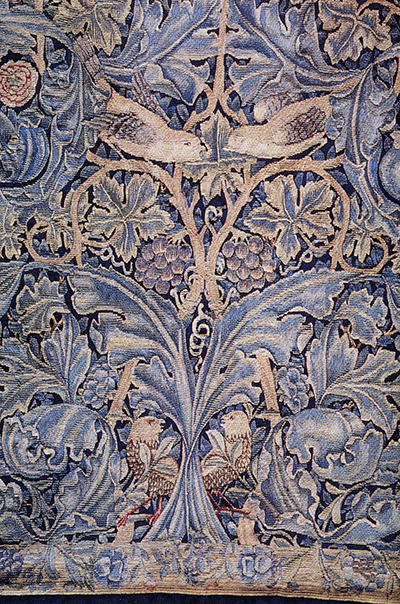William Morris produced a number of stunning tapestries within his career, with Cabbage and Vine being produced in around 1879. It is believed to have been his first tapestry woven at Kelmscott House.
We see all the hallmarks of Morris within this design, with two birds perched on vines which are intwined with the rest of the artwork. There are then beautiful purple leaves which fill other parts of the design, twisting round in a natural, seemingly random formation. Morris carefully arranges these to form a pattern that could be repeated many times over, and potentially used across different mediums as so many of his designs would be. In this case, we see a tapestry that would have taken considerable time to complete, with Morris famous for his desire to return to traditional techniques. Those who look more closely at Cabbage and Vine will see other details within this complex arrangement, including perhaps some grapes which sit just below the two birds. Morris kept to this floral approach throughout his career, though each design would alternate its content and also choose unique colour combinations which best suited each design individually. Followers of this artist will find examples of his work displayed in many large galleries and museums around the UK, with some items from his career also now on show in the US as well.
Morris was a talented artist who could pick up new skills relatively quickly, and with little coaching. He was a natural, really, and quickly started to spread his designs across different mediums in order to both keep himself curious and motivated but also to ensure the survival and profitability of his own business. This adaptability would help to bring new patrons to his door, many of whom wanted the Morris treatment for their own homes. All these years later, many still desire much the same and reproductions of his work can be delivered by a number of manufacturers who take advantage of this continued interest in his floral style. British art peaked towards the end of the 19th century and artists such as Morris were a key part of that. Although he worked alongside others within various companies, and also exhibited in different locations, it was always Morris who took the limelight and captured the public's imagination.
The combination of traditional techniques, were mass production was avoided at all costs, and also the use of animals and nature as content, produced a winning formula for all those who worked in the style of Morris. Many would copy his approach in later years, but no-one would ever achieve the same level of brilliance, quality and expertise as he did. Classes in art history and design will regularly bring up his achievements and those looking to learn similar techniques today will often refer to his oeuvre in order to gain inspiration from what was possible with the required levels of innovation and hard work. He remains regarded as one of the most influential British designers of all time and he enjoys a prominent position within the permanent collection of the V&A Museum.




